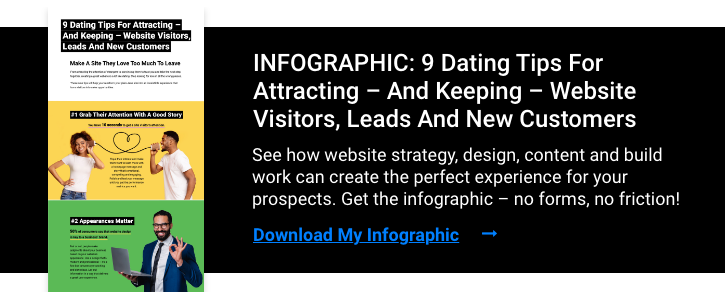
What’s The Difference Between First-Party Data And Third-Party Data?
You’ve probably started to hear more about first-party data and third-party data. At INBOUND 22, it was a major topic of conversation.
This is primarily because of privacy issues and increased regulation associated with how marketers get access to people but also due to the performance of these different types of data in driving marketing campaigns.
Before we go any further, let’s make sure everyone understands the differences.
First-party data is the data you obtain directly from your sources, meaning you own it. Ideally, it’s provided by people who want to hear from you. It is the most effective and reliable type of data.
Forbes recently reported that 41% of “high-performing marketers” are incorporating first-party data into their marketing strategies, and they said getting MarTech to support first-party data initiatives was their top technology investment priority.
Third-party data is purchased from outside sources that are not the original collector of that data. Typically, you buy it from large data aggregators that pull it from various other platforms and websites where it was generated. Aggregators often pay publishers and other data owners for their first-party data.
When you buy email addresses from ZoomInfo, you’re purchasing third-party data.
Since the purpose of this article is to help marketers and business leaders make smart decisions about their data, let’s look at what you should be doing with first-party data and the potential challenges around third-party data.
Use First-Party Data To Gain Prospect Insights
An incredible amount of actionable information is buried in your first-party data. These “insights” can be used to improve the performance of your marketing and sales activities.
Here are a few examples.
You notice people are disengaging at a 50% rate after a specific stage in the sales process. Something is happening there that is turning off your prospects and sending them elsewhere. By reviewing what the reps are doing and what information they’re sharing or not sharing, you can uncover this insight and create an action plan to improve those conversion rates.
You find a page on your website that is highly trafficked. By testing a series of gated and ungated content offers on that page, you can tune your lead generation and demand generation efforts to drive more marketing-qualified leads (MQLs) into your pipeline.
You review your last 10 videos or blogs and notice a trend toward a specific topic. Now you can tune your content strategy to lean into that topic and even expand your offering around that topic, so you attract and convert more people into conversations with your sales team.
The key to using your data to improve the performance of your program is NOT the data or even access to the data but the process of uncovering the insights.
Knowing where to look and what to look for can be tricky. Typically, this takes practice, experience and a certain skill set to peel back the onion for interesting patterns in the data.
Personalize Content And Experiences
Another important topic from INBOUND 22 was the idea that one-to-one campaigns are far more effective than one-to-many campaigns. Marketers historically want to run one-to-many campaigns because of the native efficiency.
However, today people are looking for and responding to more personal outreach, making the need to scale one-to-one campaigns a requirement going forward.
First-party data is going to be required to run these personalized campaigns, and this means more than just “Dear Ashley.” It means knowing Ashley’s role in the company, knowing her company’s industry, being able to serve up contextual images and even presenting some very specific challenges associated with her role and her industry.
It might even mean presenting content that is so personalized it speaks to her by name and provides personalized experiences that push into her web experience, like personalized video, personalized URLs and personalized content offers.
You won’t be able to do any of this without a strong database of first-party data.
Enhance Your Customer/Prospect Buyer Journey
Finally, the company that provides the best experience is likely going to be the company that wins the business.
The more you understand your prospect’s buyer journey, the better you can create a remarkable experience along that journey and the better your marketing and sales processes will perform.
Your data is going to be critical to creating that experience. This means not only personalizing it but also serving content in context.
Sales reps who can see exactly what website pages their prospects have viewed can quickly start conversations that are laser-focused on their specific issues and then serve up additional information that helps the prospects feel heard and get educated quickly.
Customer service reps who have access to similar data or online conversations can quickly diagnose issues, serve up content, follow up and turn a negative experience into a positive one.
Challenges With First-Party Data
There are some potholes associated with first-party data these days. The number one issue is getting it. Today, people are more concerned about privacy and less likely to share. Tools increasingly allow people to act anonymously, making any first-party data less helpful.
However, if you earn a person’s attention and continue to earn their participation with authentic and helpful information, most people are open to sharing their contact information and continuing to receive your information.
This is going to take work. Earning their attention and continued engagement isn’t easy — it will require investment and patience. But it’s the only way forward.
Uses For Third-Party Data
The primary use is enhancing your first-party data instead of relying entirely on third-party data.
A key challenge with your first-party data is that it lacks scale. One way to scale your data with third-party data is to take your audience data and apply it to the larger database that third-party data providers have access to.
One great example of this is using your first-party data to create a “look-alike” audience as part of a Facebook ad campaign. Now you’re targeting people who look like your current prospects.
While there is no intent data on their need for what you do, you can assume that if they look like your current crop of prospects, it’s more likely that they’re better prospects compared to a general demographic match.
Challenges With Third-Party Data
One of the biggest challenges is the quality of this data. Despite boasts by third-party data providers and their alleged artificial intelligence (AI) or personal data collection methods, these sources often struggle to provide high-quality data that marketers can consistently rely on.
Yes, this represents the allure of a massive shortcut. You can get thousands of names and email addresses for just pennies a name. But are you going to be able to use those names to drive real, high-quality leads for your sales team? Generally, the answer is no.
We’ve seen lists that struggle to hit 50% on the deliverability for email addresses.
Worse, these lists are seeded with information that could potentially get you into trouble. Spam traps are email addresses provided to third-party data companies. If you inadvertently email these addresses, you could run into trouble with your marketing automation company, email service provider, internet service provider or Google.
You could find your automation suspended, your ability to email shut down, your Google accounts turned off and your ability to even access the internet blocked.
Don’t take this lightly or dismiss this. This happens. I’ve personally seen all these scenarios.
Another significant problem is the death of the third-party cookie. New privacy laws impact the way advertisers target their prospects. This is only going to get more challenging going further. Google announced the phase-out of third-party cookies on Chrome browsers by 2022, saying “users are demanding greater privacy — including transparency, choice and control of how their data is used.”
There are no shortcuts.
Reaching prospects, driving conversations with people who are ready to buy and getting those same people to say “yes” has become an incredibly complex set of actions that all need to take place in an orchestrated way.
The data behind this process is no simpler.
Buying email addresses isn’t going to work. Trying to skip steps isn’t going to work. Instead, you’re going to have to invest and be patient while the data-driven tactics highlighted here work in concert with everything else that’s going on.
The omnichannel, orchestrated, content-driving and experienced-based approach to revenue generation is here to stay, and the sooner you start practicing it, the sooner you’ll see the growth you’re looking for in your business.

CEO and Chief Revenue Scientist
Mike Lieberman, CEO and Chief Revenue Scientist
Eliminate Hit-or-Miss Marketing Moves
Get advice, tips, tools and guidance to generate more leads for your company in this weekly email newsletter.



Eliminate Hit-or-Miss Marketing Moves
Get advice, tips, tools and guidance to generate more leads for your company in this weekly email newsletter.














